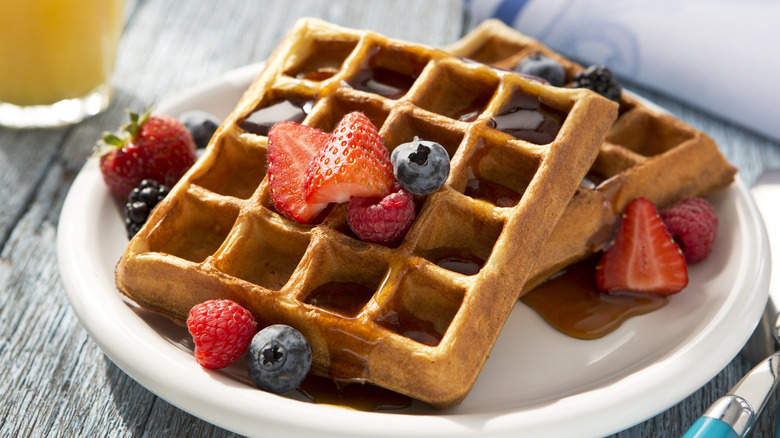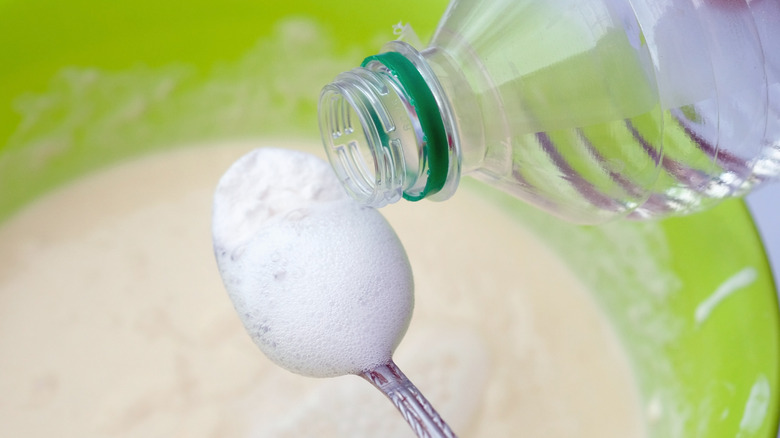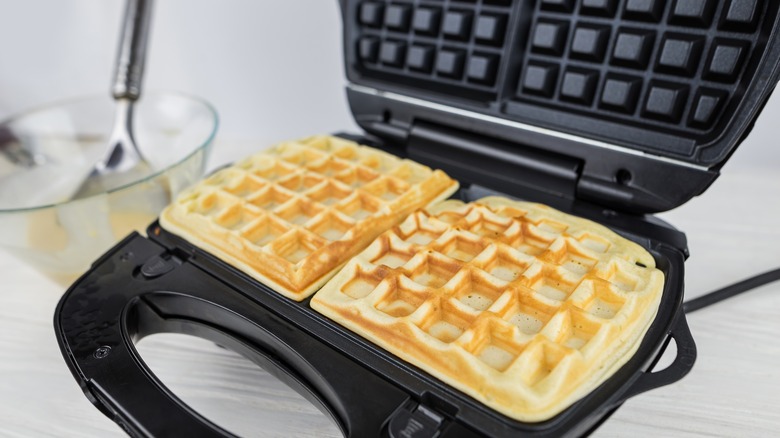The Secret To The Fluffiest Waffles Is A Little Sour Cream
The best waffles are crisp on the outside but light and fluffy on the inside. The trick to achieving the perfect texture contrast is in the batter: a little sour cream and a little nap (for the batter, of course).
Because most modern waffle recipes are leavened with chemical leaveners — baking powder and/or baking soda — the batter needs a little extra oomph to get a really good rise. That oomph comes in the form of the acidity from the sour cream. The low pH of sour cream that gives it (and subsequently, your waffles) a pleasant tang also reacts with the bicarbonate in baking soda and baking powder to create carbon dioxide, providing the lift in the batter as it cooks.
By letting the batter rest for 20 to 30 minutes, you're allowing two processes to happen. The liquid in the batter hydrates the flour, creating more flavor and a more cohesive batter. It also allows the CO2 bubbles to permeate the batter. Let it rest for too long, though, and you risk losing all the gas and, therefore, the rise. If you're working with a single waffle iron, it's probably best to let the batter rest for 10 minutes before starting the first waffle, so the last waffle is done in or around the 30-minute window.
Baking soda, baking powder, and acid: fluffiness
Baking soda and baking powder both contain a base (pH above seven) that gets neutralized when combined with an acid (pH below seven). When this occurs, a gas made of salt, water, and carbon dioxide is produced. Those little gas bubbles create rise in the batter and an airy, spongy texture when baked.
Baking soda (sodium bicarbonate) needs acid to work. If you've tried using milk in place of buttermilk in a recipe that uses baking soda and had it come out a little flat, that's why. There wasn't enough acid to activate the sodium bicarbonate. Sour cream, buttermilk, yogurt, and kefir all have that noticeable tanginess: an acidic pH. They'll activate the baking soda. Technically heat and liquid can also achieve this, but without the reaction between the baking soda and an acid, it will produce sodium carbonate, which can taste acrid.
Baking powder is made by mixing baking soda, a powdered acid, and a buffer ingredient (often cornstarch). The powdered acid, typically cream of tartar, acts as a built-in leavener and bitterness preventative, which gives you more flexibility with the pH of the recipe's ingredients. There's also double-acting baking powder, which includes one or more heat-activated acids, ensuring that, even if you let your batter rest too long or the bubbles disappear from overmixing, there's more to be generated during cooking. Still, no matter which leavener you use, a little sour cream will go a long way in your waffles.
Substitutions can be tricky to get right
It can be harder than you'd think to swap out milk for sour cream in your favorite waffle recipe. Waffles are more baking than cooking, which means they're highly subject to chemistry; the way the ingredients interact with each other will determine the success of your waffles. Milk has a higher water content than sour cream and will create a looser, more hydrated dough, and the right waffle batter consistency is critical. Sour cream has a higher percentage of milk fat, which will create a more tender, cakey batter. Milk has higher lactose sugar, leading to more surface browning. If the formula for your batter is off, your waffles can turn out too runny or too thick, too tough or too gummy, too light (drying out as you cook longer), or too dark (undercooked to prevent burning).
If you're interested in converting an old waffle recipe to new ingredients, it could take many instances of trial and error while you rebalance it and figure out which waffle mistakes to avoid. It's best to start with a waffle recipe that was specifically developed for the ingredients you have. This way, you get the fluffy, delicious waffles you were looking for.


